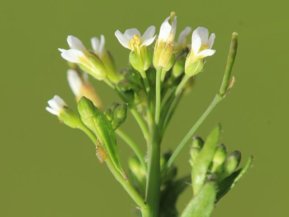
Arabidopsis thaliana is a small flowering plant that is widely used as a model organism in plant biology. Arabidopsis is a member of the mustard (Brassicaceae) family, which includes cultivated species such as cabbage and radish. Arabidopsis is not of major agronomic significance, but it offers important advantages for basic research in genetics and molecular biology.
This little plant has become to plant biology what Drosophila melanogaster and Caenorhabditis elegans are to animal biology. Arabidopsis is an angiosperm, a dicot from the mustard family (Brassicaceae). It is popularly known as thale cress or mouse-ear cress. While it has no commercial value — in fact is considered a weed — it has proved to be an ideal organism for studying plant development.
Some of its advantages as a model organism:
1. It has one of the smallest genomes in the plant kingdom: 135 x 106 base pairs of DNA distributed in 5 chromosomes (2n = 10) and almost all of which encodes its 27,407 genes.
2. Transgenic plants can be made easily using Agrobacterium tumefaciens as the vector to introduce foreign genes.
3. The plant is small — a flat rosette of leaves from which grows a flower stalk 6–12 inches high.
4. It can be easily grown in the lab in a relatively small space.
5. Development is rapid. It only takes 5– 6 weeks from seed germination to the production of a new crop of seeds.
6. It is a prolific producer of seeds (up to 10,000 per plant) making genetics studies easier.
7. Mutations can be easily generated (e.g., by irradiating the seeds or treating them with mutagenic chemicals).
8. It is normally self-pollinated so recessive mutations quickly become homozygous and thus expressed.
In PAmiRDB, 428 miRNA from A.thaliana are scanned against viral genomes, in order to get insight into viral genome and miRNA intractions.